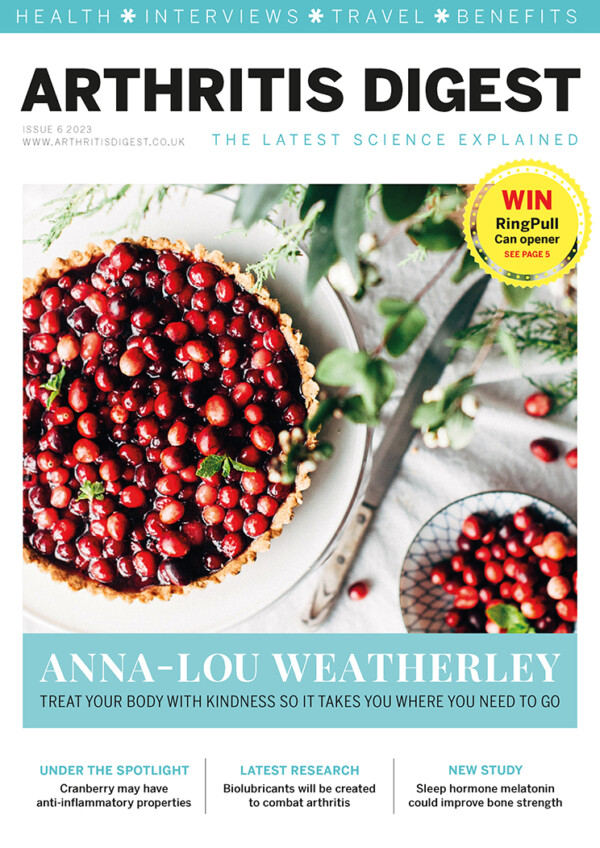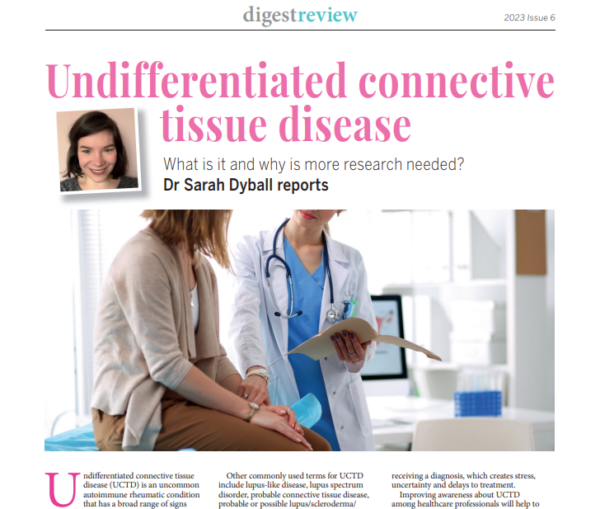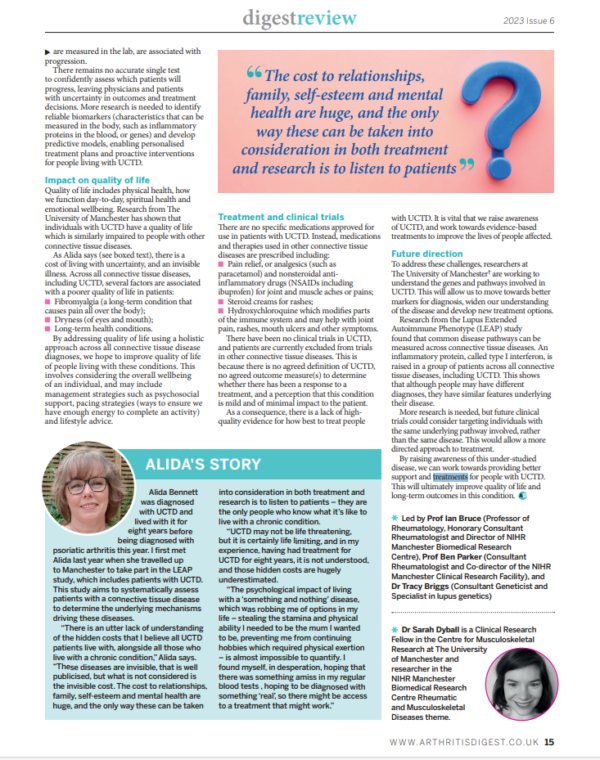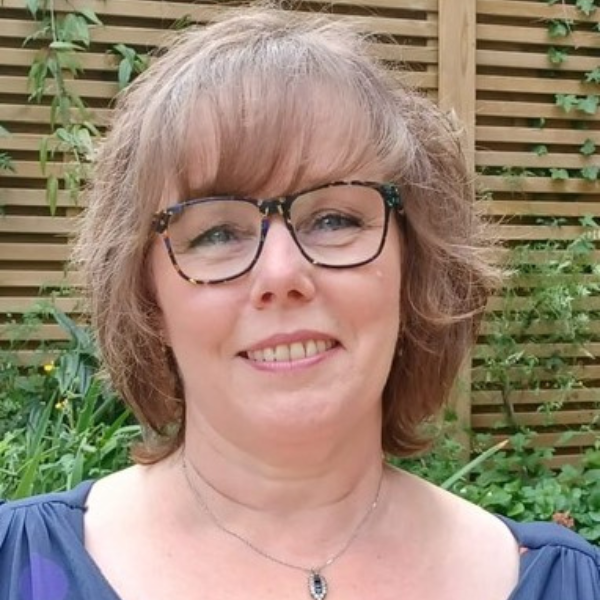Undifferentiated connective tissue disease – what is it and why is more research needed? Dr Sarah Dyball speaks to Arthritis Digest
Arthritis Digest is a magazine for people with arthritis that highlights the latest relevant research and reviews topical issues.
Continuing regular contributions from our Rheumatic and Musculoskeletal Diseases theme researchers, Dr Sarah Dyball, Clinical Research Fellow at The University of Manchester and The Kellgren Centre for Rheumatology at Manchester University NHS Foundation Trust, explains what undifferentiated connective tissue disease is and why more research is needed.
Undifferentiated connective tissue disease (UCTD) is an uncommon autoimmune rheumatic condition that has a broad range of signs and symptoms.
People with UCTD have symptoms and lab test results which are not extensive or specific enough to meet criteria for a diagnosis of a defined connective tissue disease such as systemic lupus erythematosus (lupus), rheumatoid arthritis, systemic sclerosis (scleroderma), Sjögren’s disease or myositis.
The most common symptoms of UCTD include joint pain, Raynaud’s phenomenon (colour changes of the fingers in response to cold temperature), dryness of the eyes and mouth, a facial rash which is sensitive to sunlight, inflammation of the lung lining (pleurisy) or heart lining (pericarditis) and recurrent mouth ulcers.

People with UCTD have auto-antibodies in their blood. These are antibodies produced by the immune system that mistakenly target and attack the body’s own healthy cells and tissues instead of protecting them. The cause of UCTD is not known, but it is thought that these auto-antibodies contribute to symptoms.
Other commonly used terms for UCTD include lupus-like disease, lupus spectrum disorder, probable connective tissue disease, probable or possible lupus/scleroderma/ Sjögren’s, and pre-scleroderma.
Challenges in diagnosis

UCTD is a clinical diagnosis, usually made by a rheumatologist. However, there are a number of challenges in the diagnostic process. Classification criteria are often used in rheumatology research to define a “typical” group of patients with a disease. However, no specific diagnostic or classification criteria are widely used for UCTD because:
- There is a lack of research in this area;
- Its signs and symptoms are highly variable so it is difficult to define;
- There is no consensus about the number of lab and clinical features that a patient should have in order to be diagnosed.
The varied and non-specific symptoms of UCTD can overlap with other conditions such as lupus, systemic sclerosis and Sjögren’s disease. These challenges lead to delays in diagnosis. It is not uncommon for individuals to visit multiple healthcare professionals before receiving a diagnosis, which creates stress, uncertainty and delays to treatment.
Improving awareness about UCTD among healthcare professionals will help to ensure timely and accurate diagnosis, and facilitate access to appropriate treatment and support.
Collaboration between patients, healthcare providers and researchers, to identify patient-focused research priorities is essential in driving progress in knowledge and understanding of this condition. This will ultimately improve the lives of people with UCTD.
Predicting disease progression
Approximately one-third of people with UCTD progress to a definitive connective tissue disease diagnosis. This means they develop new symptoms (or current symptoms worsen) and the person is then diagnosed with a definitive connective tissue disease, for example lupus.
We don’t yet know how to predict who is at the greatest risk of progression. Clinical features, such as a butterfly rash, or inflammation in the lining of the lung (pleurisy) or heart (pericarditis), or the presence of particular auto-antibodies which are measured in the lab, are associated with progression.
There remains no accurate single test to confidently assess which patients will progress, leaving physicians and patients with uncertainty in outcomes and treatment decisions. More research is needed to identify reliable biomarkers (characteristics that can be measured in the body, such as inflammatory proteins in the blood, or genes) and develop predictive models, enabling personalised treatment plans and proactive interventions for people living with UCTD.

Impact on quality of life
Quality of life includes physical health, how we function day-to-day, spiritual health and emotional wellbeing. Research from The University of Manchester has shown that individuals with UCTD have a quality of life which is similarly impaired to people with other connective tissue diseases. As Alida says (read her story below), there is a cost of living with uncertainty, and an invisible illness. Across all connective tissue diseases, including UCTD, several factors are associated with a poorer quality of life in patients:
- Fibromyalgia (a long-term condition that causes pain all over the body);
- Dryness (of eyes and mouth);
- Long-term health conditions.
By addressing quality of life using a holistic approach across all connective tissue disease diagnoses, we hope to improve quality of life of people living with these conditions. This involves considering the overall wellbeing of an individual, and may include management strategies such as psychosocial support, pacing strategies (ways to ensure we have enough energy to complete an activity) and lifestyle advice.
Treatment and clinical trials
There are no specific medications approved for use in patients with UCTD. Instead, medications and therapies used in other connective tissue diseases are prescribed including:
- Pain relief, or analgesics (such as paracetamol) and nonsteroidal anti-inflammatory drugs (NSAIDs including ibuprofen) for joint and muscle aches or pains;
- Steroid creams for rashes;
- Hydroxychloroquine which modifies parts of the immune system and may help with joint pain, rashes, mouth ulcers and other symptoms.

There have been no clinical trials in UCTD, and patients are currently excluded from trials in other connective tissue diseases. This is because there is no agreed definition of UCTD, no agreed outcome measure(s) to determine whether there has been a response to a treatment, and a perception that this condition is mild and of minimal impact to the patient.
As a consequence, there is a lack of high-quality evidence for how best to treat people with UCTD. It is vital that we raise awareness of UCTD, and work towards evidence-based treatments to improve the lives of people affected.
Future direction
To address these challenges, researchers at The University of Manchester led by Prof Ian Bruce (Professor of Rheumatology, Honorary Consultant Rheumatologist and Director of NIHR Manchester Biomedical Research Centre), Prof Ben Parker (Consultant Rheumatologist and Co-director of the NIHR Manchester Clinical Research Facility), and Dr Tracy Briggs (Consultant Geneticist and Specialist in lupus genetics), are working to understand the genes and pathways involved in UCTD. This will allow us to move towards better markers for diagnosis, widen our understanding of the disease and develop new treatment options.
Research from the Lupus Extended Autoimmune Phenotype (LEAP) study found that common disease pathways can be measured across connective tissue diseases. An inflammatory protein, called type I interferon, is raised in a group of patients across all connective tissue diseases, including UCTD. This shows that although people may have different diagnoses, they have similar features underlying their disease.
More research is needed, but future clinical trials could consider targeting individuals with the same underlying pathway involved, rather than the same disease. This would allow a more directed approach to treatment.
By raising awareness of this under-studied disease, we can work towards providing better support and treatments for people with UCTD. This will ultimately improve quality of life and long-term outcomes in this condition.
Alida’s story
Alida Bennett was diagnosed with UCTD and lived with it for eight years before being diagnosed with psoriatic arthritis this year. I first met up with Alida last year when she travelled up to Manchester to take part in the LEAP study, which includes patients with UCTD. This study aims to systematically assess patients with a connective tissue disease to determine the underlying mechanisms driving these diseases.
“There is an utter lack of understanding of the hidden costs that I believe all UCTD patients live with, alongside all those who live with a chronic condition,” Alida says.

“These diseases are invisible, that is well publicised, but what is not considered is the invisible cost. The cost to relationships, family, self-esteem and mental health are huge, and the only way these can be taken into consideration in both treatment and research is to listen to patients – they are the only people who know what it’s like to live with a chronic condition.
“UCTD may not be life threatening, but it is certainly life limiting, and in my experience, having had treatment for UCTD for eight years, it is not understood, and those hidden costs are hugely underestimated.
The psychological impact of living with a ‘something and nothing’ disease, which was robbing me of options in my life – stealing the stamina and physical ability I needed to be the mum I wanted to be, preventing me from continuing hobbies which required physical exertion – is almost impossible to quantify. I found myself, in desperation, hoping that there was something amiss in my regular blood tests, hoping to be diagnosed with something ‘real’, so there might be access to a treatment that might work.